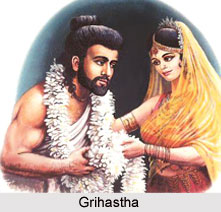 Every doctrine of ancient India is logically based. The then Hindu masters had carved out several doctrines based on scientific and rational reasoning. To put them to use they needed to be socially embedded. Hence methods like, the Ashram system, were included in the society. The life of an individual was based on both Karma and Dharma. The average life of an Indian was considered to be 100 years. Based on this life was divided into 4 stages-Brahmacharya, Grihastha, Vanaprastha and Sannyasa. The goal of each stage was to fulfill the ideals on which these stages were divided.
Every doctrine of ancient India is logically based. The then Hindu masters had carved out several doctrines based on scientific and rational reasoning. To put them to use they needed to be socially embedded. Hence methods like, the Ashram system, were included in the society. The life of an individual was based on both Karma and Dharma. The average life of an Indian was considered to be 100 years. Based on this life was divided into 4 stages-Brahmacharya, Grihastha, Vanaprastha and Sannyasa. The goal of each stage was to fulfill the ideals on which these stages were divided.
Ashram literally means a resting place of a hermit that is located in the deep forest so that he could practice asceticism. The four stages of the Vedic Life, thus, stratify the duties that man has to practice in his lifetime. These four divisions are elucidated in Manuscript. The theologian explains that to attain immortality man has to bear his responsibilities. He, who, successfully walks on the path of dharma and karma will definitely attain salvation. Later in the Vedic Life the concept of four Ashrams developed which built the characters and also, in a way, strengthened the traditions of society and family.
With such methodology the then contemporary society also aimed at holding the social institutions together. Instead of becoming sages and escaping from worldly duties man was taught to shoulder every social and personal obligations. Apart from these the four stages of life also led to spiritual development. From an early age man was shown the paths of ethics, self-restraint, intelligence, pragmatism, love, compassion and discipline. He was guided to stay away from greed, cruelty, sloth, pride and several other vices. This system was also beneficial for the society at large. If every individual knows his job and leads his life accordingly then the society will definitely thrive.
According to the four ashrams of life a man was expected to lead his life in 4 stages: -
 1. Brahmacharya: - This stage is the first one and it begins at the age of 20 and extends up to 25 years. This is the time when man leads the life of student and practices celibacy. The motto of this phase is to train man to discipline himself. This is the perfect time to inculcate values like self-restraint, knowledge and obedience.
1. Brahmacharya: - This stage is the first one and it begins at the age of 20 and extends up to 25 years. This is the time when man leads the life of student and practices celibacy. The motto of this phase is to train man to discipline himself. This is the perfect time to inculcate values like self-restraint, knowledge and obedience.
2. Grihastha: - At this point of time man needs to pay heed to his social and family life. This phase begins from 25 and lasts till 60 years. Grihastha is a crucial stage in one`s life where man has to balance both his familial and social duties. He is married and manages his household and at the same time looks after the needs of the world outside. This is the first stage where he puts his knowledge to use. He has to discharge the duties of a son, brother, husband, father and a member of the community. From here he moves onto the next stage.
 3. Vanaprastha: - This is the step to Partial renunciation. This stage ushers in the life of man at an age of 50 and lasts till he is 74. His children are grown up and he slowly moves away for the material ties. It is his age for retirement and starts walking on a path that will lead him to the Divine.
3. Vanaprastha: - This is the step to Partial renunciation. This stage ushers in the life of man at an age of 50 and lasts till he is 74. His children are grown up and he slowly moves away for the material ties. It is his age for retirement and starts walking on a path that will lead him to the Divine.
4. Sannyasa: The last stage in his life comes when he completely snaps off his worldly ties. This phase begins at 74 and lasts till he dies. He is completely free from the emotional attachments. It is at this age that he becomes an ascetic and completely dedicates his life to serve God.
The Four Stages of Life reiterates what the Indian saints have always professed. A true devotee is he who knows his duties and fulfills them. Society needs both kinds of people-he who abandons all to pursue god and he who stay within a social institution and strike a balance between Karma and Dharma. Ideas like this can never grow old. As a result the Ashram System is still followed in India, consciously or unconsciously. Although they are not strictly implemented but even today an Indian has a life of a student, a family man, then he retires. As old age seeps in, he passes on his responsibilities to his children and moves closer to spiritualism.



















